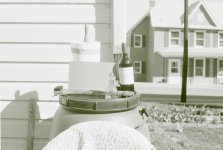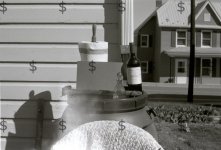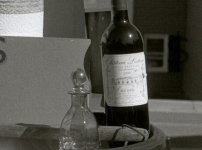kmack
do your job, then let go
I have been getting some very flat scans using the software that is supplied with my KM scan dual III. I decided to try vuescan to see if there was a difference. I shot a series of test photos using my Bessa R, Industar 61 lens. I used FP4+ film, rated it at 64 ISO and started at f2.5 and shot every 1/2 stop up to f16. It was a very sunny day so the 'sunny 16' rule applied. I developed the negatives in HC110 Dilution G, 20C for 18 min agitation: 1 min at start, 5 inversions every 3min.
I scanned as color slides, all default settings.
The results of f5.6 are posted below. No post processing, just invert, resize and convert from tif to jpeg. OS - MAC 10.4 -- GIMP
1. full frame using km software
2. full frame using vuescan
3. clip at 100% km software
4. clip at 100% vuescan
I scanned as color slides, all default settings.
The results of f5.6 are posted below. No post processing, just invert, resize and convert from tif to jpeg. OS - MAC 10.4 -- GIMP
1. full frame using km software
2. full frame using vuescan
3. clip at 100% km software
4. clip at 100% vuescan
Attachments
planetjoe
Just some guy, you know?
Unfortunately, I can't comment on the KM software - I am using KM hardware, specifically the Scan Multi, but I've been Vuescan-only for about a year and a half, now. Once I learned it enough to use it to my liking (I'm STILL learning it, of course), I found that it's a pretty incredible little piece of software. Well worth the cost of a lifetime license, IMHO.
Is that "haze" in the lower center of the second image an artifact of some kind?
Maybe KM software decided to go funky, now that KM is officially toast. Anyhow, good luck with your software quest.
Cheers,
--joe.
Is that "haze" in the lower center of the second image an artifact of some kind?
Maybe KM software decided to go funky, now that KM is officially toast. Anyhow, good luck with your software quest.
Cheers,
--joe.
peterc
Heretic
Have you tried the KM software scanning as a B&W negative? I've found the results to be quite good.
Peter
Peter
kmack
do your job, then let go
planetjoe said:Is that "haze" in the lower center of the second image an artifact of some kind?
--joe.
Cat related damage to the negitive while changing the negitive holder. Cat decides it is time to play, negitive ends up under the wheel of the chair
kmack
do your job, then let go
Yes, I tried that. The results were better but I was getting a lot of clipping of the highlights and the tonal range seemed to be compressed. The tonality I got out of the simple test with Vuescan was amazing.peterc said:Have you tried the KM software scanning as a B&W negative? I've found the results to be quite good.
Peter
peterc
Heretic
Interesting. I tried Vuescan with my Minolta and the results were terrible.kmack said:The tonality I got out of the simple test with Vuescan was amazing.
Peter
kmack
do your job, then let go
Hummmm...Mac or Windows?
planetjoe
Just some guy, you know?
Yikes - cat damage. That sounds nasty.
I wish I could suggest something else to help this issue, especially PeterC's...Peter, which KM scanner are you using?
I originally had a devil of a time with artifacts, noise, etc. - now I have a kind of "surefire" administrative workflow, at least for B&W images:
1. allow scanner to warm up for ~30 minutes (simply power it on; mine is almost always on)
2. start Vuescan, then "calibrate scanner". I've found this eliminates the nasty streaky bits I sometimes got. Ed Hamrick actually sugegsted this a while back in an email exchange. (It's nice to be able to ask the software developer direct questions.)
3. scan BW images as RGB, but "Preview" first and lock exposure based on a general image scene.
4. "Release memory" (I have a dog of a PC) and batch scan away.
I realize this may be obvious to most. I guess I just feel like typing.
Cheers,
--joe.
I wish I could suggest something else to help this issue, especially PeterC's...Peter, which KM scanner are you using?
I originally had a devil of a time with artifacts, noise, etc. - now I have a kind of "surefire" administrative workflow, at least for B&W images:
1. allow scanner to warm up for ~30 minutes (simply power it on; mine is almost always on)
2. start Vuescan, then "calibrate scanner". I've found this eliminates the nasty streaky bits I sometimes got. Ed Hamrick actually sugegsted this a while back in an email exchange. (It's nice to be able to ask the software developer direct questions.)
3. scan BW images as RGB, but "Preview" first and lock exposure based on a general image scene.
4. "Release memory" (I have a dog of a PC) and batch scan away.
I realize this may be obvious to most. I guess I just feel like typing.
Cheers,
--joe.
peterc
Heretic
peterc
Heretic
It's an old Dual Scan Elite, Joe. I've tried vuescan a couple of times with it. I also tried the calibrate and went through all the different scan as positive, scan as RGB etc. suggestions I'd seen. Got nothing I really liked.planetjoe said:Peter, which KM scanner are you using?
I've fiddled with the settings in the KM software and found a combination that seems to work pretty well ... not quite as sharp as my deceased Nikon LS2000 (but it had focus adjust).
Peter
dmr
Registered Abuser
peterc said:Have you tried the KM software scanning as a B&W negative? I've found the results to be quite good.
Something is majorly wrong here, something with respect to levels.
Are you making any level adjustments in the prescan phase?
Are you scanning in 16 bit so you have adequate detail to make some major corrections in post processing?
I did some test scans a while back with a B&W negative and even though the methods of scanning in color offered some improvement over the B&W only, all of them produced a reasonably normal scan.
Your scans 1 and 3 are definitely not normal, and I can attest that the stock software can do better on any kind of a sane B&W negative.
bmattock
Veteran
I love vuescan - but then again, I run Linux only. Vuescan & The Gimp are all I have except for my scanner and a cheap bottle of muscatel.
Best Regards,
Bill Mattocks
Best Regards,
Bill Mattocks
kmack
do your job, then let go
dmr said:Something is majorly wrong here, something with respect to levels.
Are you making any level adjustments in the prescan phase?
Are you scanning in 16 bit so you have adequate detail to make some major corrections in post processing?
I did some test scans a while back with a B&W negative and even though the methods of scanning in color offered some improvement over the B&W only, all of them produced a reasonably normal scan.
Your scans 1 and 3 are definitely not normal, and I can attest that the stock software can do better on any kind of a sane B&W negative.
Yes, scanning at 16 bit. That's why I tested as I did. I have been attempting to develop a consistant film, development, scanner work flow. I found that with the KM software I would have to rate FP4+ at about 500 ISO to get an acceptable scan that would not require a lot of post processing. At that point I decided to try different scanning software. As I posted above it is a Scan Dual III so the software is version 1. I get consistant results between Mac and Windows.
Needless to say, Mr. Hamrick is going to get some of my money very soon.
Gabriel M.A.
My Red Dot Glows For You
I've harped on this before: the bundled software that comes with the Minolta scanners is a piece of ****. The user interface gets good marks (good, not great), it's a lot more than many other solutions out there, but the results from it are just plain bad, and at best, mediocre.
Many people, as you've seen, report great results using VueScan (you must get acquainted with the software, don't expect miracles by just pressing the button). I use SilverFast SE. I scan the "raw" (HDR) file, and then post-process with SilverFast HDR. If the image is not that big of a deal (i.e. "not a keeper"), just plain old 8-bit scanning within SE is sufficient.
It's a long learning process, don't get discouraged. There are way too many variables.
Many people, as you've seen, report great results using VueScan (you must get acquainted with the software, don't expect miracles by just pressing the button). I use SilverFast SE. I scan the "raw" (HDR) file, and then post-process with SilverFast HDR. If the image is not that big of a deal (i.e. "not a keeper"), just plain old 8-bit scanning within SE is sufficient.
It's a long learning process, don't get discouraged. There are way too many variables.
GeneW
Veteran
I'm a longtime Vuescan user and find it an excellent piece of software that gets improved continually. My starting point with scans is for a fairly flat image and I expect to do quite a bit of work on it in Photoshop. I scan to 16-bit TIFF and work from there.
Gene
Gene
JohnL
Very confused
I use the original KM software with a Dual IV and find the results very faithful to the image, by which I mean that when it's not satisfactory, it's invariably a fault with exposure or processing (or just age). I only did a few B&W negs, quite a few old Kodachrome slides, some recent Provia slides and lots and lots of color negative.
thafred
silver addict
I allways work with the Minolta software because I just batch scan in 16bit and do everything in PS (works well for me with B/W and Slides) ...with FP4 and (in my case) T-Max developer, i found it really important to not use the times written on the box (about 8min) but consult Massive dev. chart (4,5min ..works super ...thinner Negs=better scanning) ...however recently I´m scanning a lot of Colour Neg Film and have huge Problems with high density Neg´s and banding (esp in blue areas like sky) from The scan Dual IV...a friend of mine stressed using Vuescan and adjusting exposure .. I have tried it and it did´t work at all but the colours and saturation were better right of the scanner!
I guess the thing is, that if you want perfect pictures right out of the scanner Vuescan will make you happy but if you just use the scanners software to bring something to work on into PS (or GIMP or whatever) the KM Software will suffice.
regards
fred
I guess the thing is, that if you want perfect pictures right out of the scanner Vuescan will make you happy but if you just use the scanners software to bring something to work on into PS (or GIMP or whatever) the KM Software will suffice.
regards
fred
thafred
silver addict
Oh eh...LohnL
When you say you do alot of Color Neg´s with the minolta, do you notice bad streaks in sky or light grey areas (or high density areas in the neg) or is it just my DS4 wich does that?
(I started to think that the KM DS4 isn´t really suted for C41 Negs but maybe it´s just my sample )
)
thanks
fred
When you say you do alot of Color Neg´s with the minolta, do you notice bad streaks in sky or light grey areas (or high density areas in the neg) or is it just my DS4 wich does that?
(I started to think that the KM DS4 isn´t really suted for C41 Negs but maybe it´s just my sample
thanks
fred
dmr
Registered Abuser
JohnL said:I use the original KM software with a Dual IV and find the results very faithful to the image, by which I mean that when it's not satisfactory, it's invariably a fault with exposure or processing (or just age). I only did a few B&W negs, quite a few old Kodachrome slides, some recent Provia slides and lots and lots of color negative.
I'm starting to wonder if some of the older KM software is indeed a "piece of {drek}" and the newer versions are much improved or corrected?
My version is as of last fall, and it's always worked fine for me, once I climbed enough on the learning curve, that is.
I always wondered why some people here, those whose opinions I value, are so in love with Vuescan, since when I tried the demo version I didn't see any real improvement or any speed-up or ergonomic advantage.
I'm beginning to think now that some of the earlier stock KM software did indeed have issues.
kaiyen
local man of mystery
I guess the thing is, that if you want perfect pictures right out of the scanner Vuescan will make you happy but if you just use the scanners software to bring something to work on into PS (or GIMP or whatever) the KM Software will suffice.
I mean no offense when I say this, but that is about as backwards a comment about Vuescan as I have ever heard or would ever make. I find that I can get so much more information out of Vuescan than NikonScan (can't compare to KM software if I don't have a KM scanner) and have so much more control.
And if someone, _anyone_, has to shoot FP4 at _500_ to get acceptale straight scans out of the KM software then something is truly wrong..
allan
Share:
-
This site uses cookies to help personalise content, tailor your experience and to keep you logged in if you register.
By continuing to use this site, you are consenting to our use of cookies.




